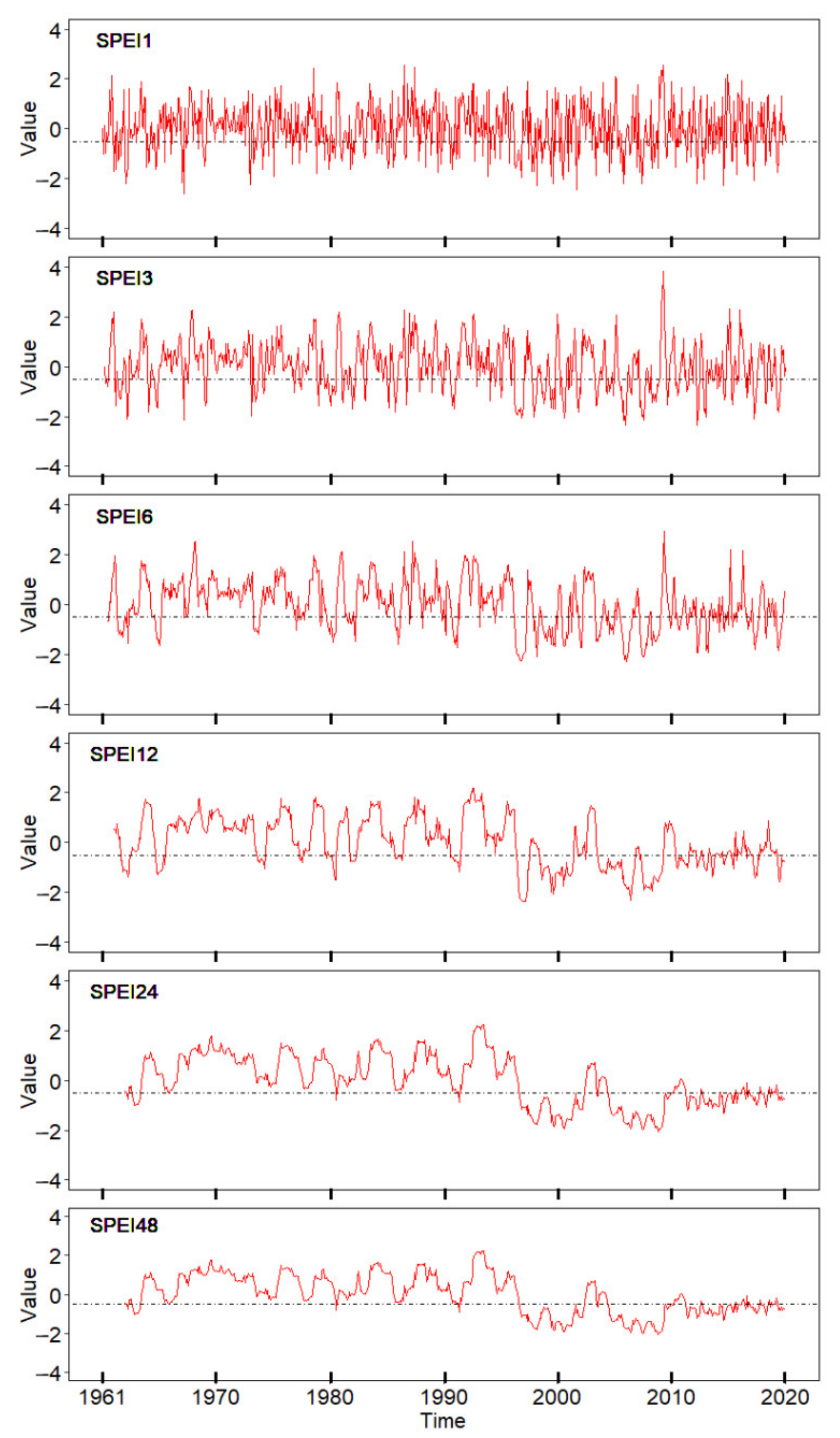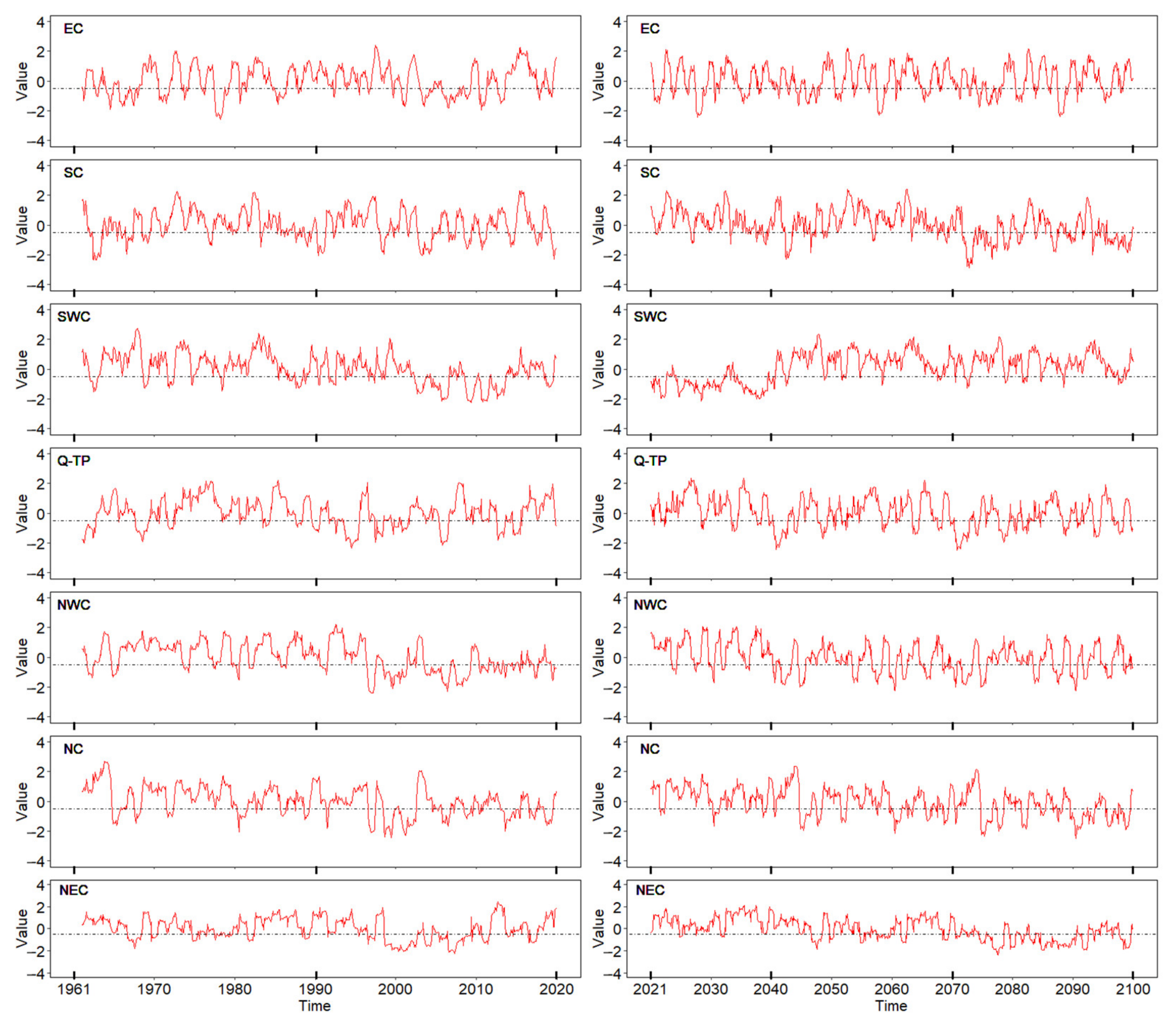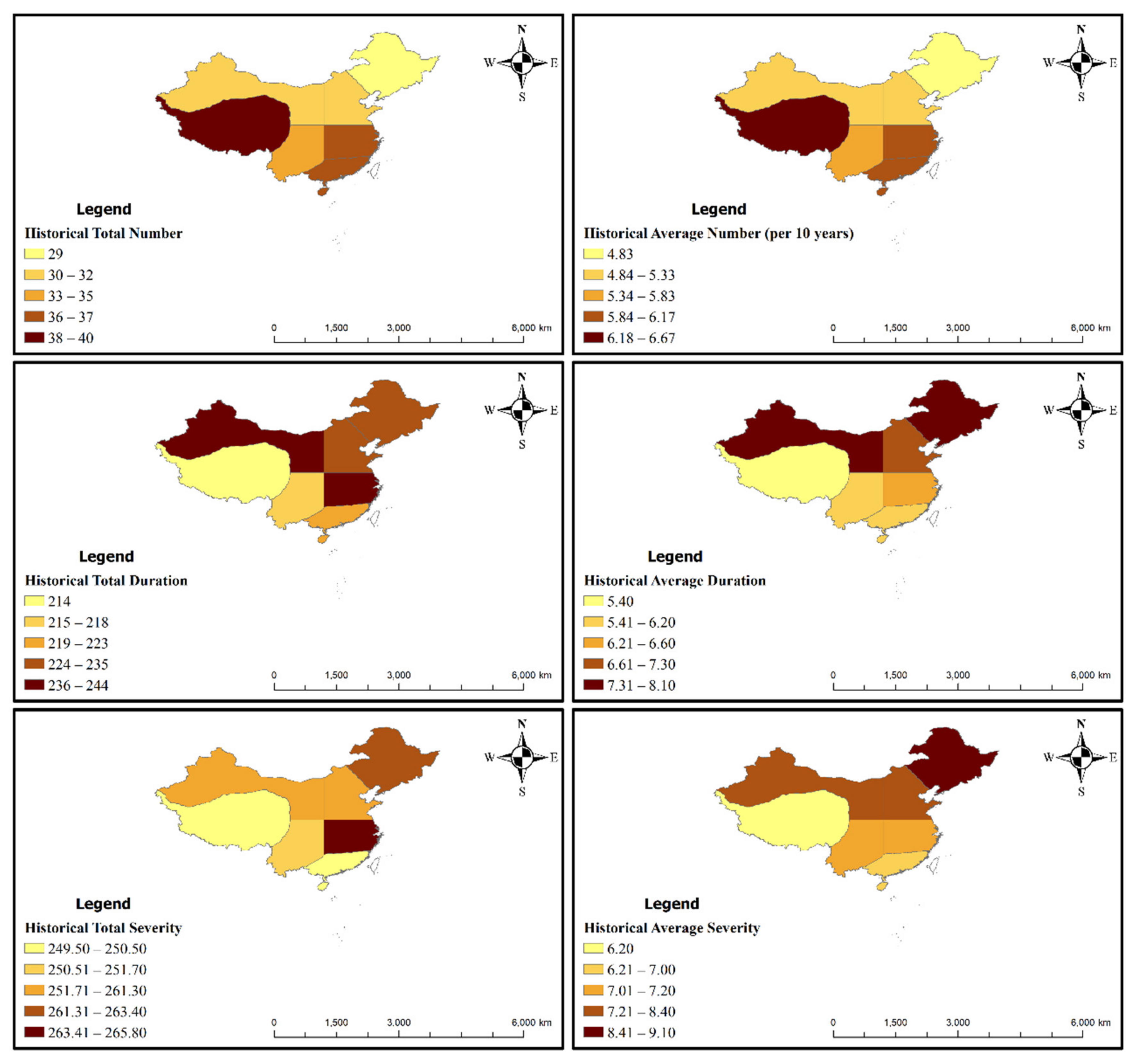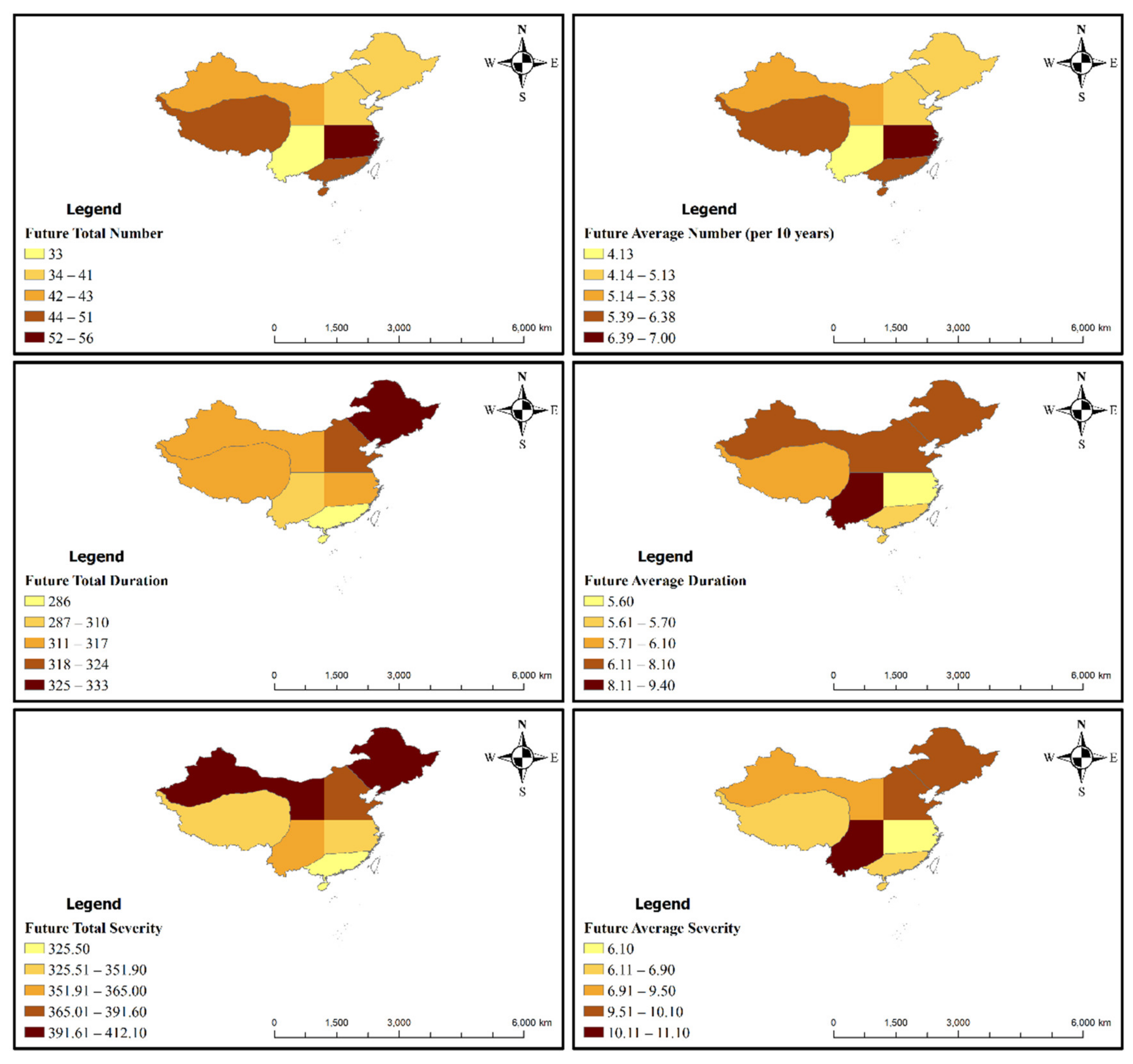Spatial–Temporal Assessment of Historical and Future Meteorological Droughts in China
Abstract
1. Introduction
2. Study Area and Data
2.1. Study Area
2.2. Historical and Future Precipitation and Temperature Data
3. Methodology
3.1. Standardized Precipitation Evapotranspiration Index and Run Theory
3.2. Mann–Kendall Test and Sen’s Slope
4. Results
4.1. The Determination of Timescale for SPEI Calculation
4.2. The Assessment of Historical Droughts
4.2.1. Trends of Historical Droughts
4.2.2. Characteristics of Historical Droughts
4.3. The Assessment of Future Droughts
4.3.1. Trends of Future Droughts
4.3.2. Characteristics of Future Droughts
5. Discussion
6. Conclusions and Limitations
- Twelve-month SPEI could not only reflect the long-term trend but also maintain interannual drought changes and have low susceptibility to extreme events. It is more suitable for assessing meteorological drought over a long time span.
- In the historical period of 1961–2020, the number of droughts decreased gradually from the south of China to the north. The northeast and the northern areas of China (NWC, NC and NEC) experienced less frequent droughts, yet with a longer duration and stronger severity per drought event, and the western, the southwest and the southeast areas of China (EC, SC, SWC, and Q-TP) experienced more frequent droughts, yet with a shorter duration and weaker severity per drought event.
- In the future period of 2021–2100, most areas of China (especially for NEC, NC, Q-TP and SWC) are projected to suffer more severe droughts with longer duration. Specific to sub-regions, more frequent drought was predicted in EC, SC and Q-TP with relatively shorter duration and weaker severity. Less frequent drought but with longer duration and stronger severity was predicted in the northern areas of China (NWC, NC and NEC), indicating that these areas may still be more vulnerable to droughts. SWC may suffer more severe single droughts with longer duration in the future, meaning that this area is projected to be greatly affected by droughts during 2021–2100.
Author Contributions
Funding
Institutional Review Board Statement
Informed Consent Statement
Data Availability Statement
Acknowledgments
Conflicts of Interest
References
- Mishra, A.K.; Singh, V.P. A review of drought concepts. J. Hydrol. 2010, 391, 202–216. [Google Scholar] [CrossRef]
- Piao, S.; Ciais, P.; Huang, Y.; Shen, Z.; Peng, S.; Li, J.; Zhou, L.; Liu, H.; Ma, Y.; Ding, Y.; et al. The impacts of climate change on water resources and agriculture in China. Nature 2010, 467, 43–51. [Google Scholar] [CrossRef] [PubMed]
- Atlas of Mortality and Economic Losses from Weather, Climate and Water Extremes. Available online: https://public.wmo.int/en/our-mandate/water/drought (accessed on 5 June 2021).
- Drought Conditions and Management Strategies in China. Available online: http://www.droughtmanagement.info/literature/UNW-DPC_NDMP_Country_Report_China_2014.pdf (accessed on 5 June 2021).
- Ashrafi, S.M.; Gholami, H.; Najafi, M.R. Uncertainties in runoff projection and hydrological drought assessment over Gharesu basin under CMIP5 RCP scenarios. J. Water Clim. 2020, 11, 145–163. [Google Scholar] [CrossRef]
- Adib, A.; Mirsalari, S.B.; Ashrafi, S.M. Prediction of meteorological and hydrological phenomena by different climatic scenarios in the Karkheh watershed (south west of Iran). Sci. Iran. 2020, 27, 1814–1825. [Google Scholar] [CrossRef]
- Sung, J.H.; Park, J.; Jeon, J.-J.; Seo, S.B. Assessment of Inter-Model Variability in Meteorological Drought Characteristics Using CMIP5 GCMs over South Korea. KSCE J. Civ. Eng. 2020, 24, 2824–2834. [Google Scholar] [CrossRef]
- Spinoni, J.; Barbosa, P.; De Jager, A.; McCormick, N.; Naumann, G.; Vogt, J.V.; Magni, D.; Masante, D.; Mazzeschi, M. A new global database of meteorological drought events from 1951 to 2016. J. Hydrol. Reg. Stud. 2019, 22, 100593. [Google Scholar] [CrossRef]
- Sharafati, A.; Nabaei, S.; Shahid, S. Spatial assessment of meteorological drought features over different climate regions in Iran. Int. J. Climatol. 2019, 40, 1864–1884. [Google Scholar] [CrossRef]
- Spinoni, J.; Barbosa, P.; Bucchignani, E.; Cassano, J.; Cavazos, T.; Christensen, J.H.; Christensen, O.B.; Coppola, E.; Evans, J.; Geyer, B.; et al. Future Global Meteorological Drought Hot Spots: A Study Based on CORDEX Data. J. Clim. 2020, 33, 3635–3661. [Google Scholar] [CrossRef]
- Campozano, L.; Ballari, D.; Montenegro, M.; Avilés, A. Future Meteorological Droughts in Ecuador: Decreasing Trends and Associated Spatio-Temporal Features Derived from CMIP5 Models. Front. Earth Sci. 2020, 8. [Google Scholar] [CrossRef]
- Jincy Rose, M.A.; Chithra, N.R. Evaluation of temporal drought variation and projection in a tropical river basin of Kerala. J. Water Clim. Chang. 2020, 11, 115–132. [Google Scholar] [CrossRef]
- Nuri Balov, M.; Altunkaynak, A. Spatio-temporal evaluation of various global circulation models in terms of projection of different meteorological drought indices. Environ. Earth Sci. 2020, 79, 126. [Google Scholar] [CrossRef]
- Lu, E.; Luo, Y.; Zhang, R.; Wu, Q.; Liu, L. Regional atmospheric anomalies responsible for the 2009–2010 severe drought in China. J. Geophys. Res. Atmos. 2011, 116. [Google Scholar] [CrossRef]
- Zhang, L.; Xiao, J.; Li, J.; Wang, K.; Lei, L.; Guo, H. The 2010 spring drought reduced primary productivity in southwestern China. Environ. Res. Lett. 2012, 7, 045706. [Google Scholar] [CrossRef]
- Zhao, C.; Deng, X.; Yuan, Y.; Yan, H.; Liang, H. Prediction of Drought Risk Based on the WRF Model in Yunnan Province of China. Adv. Meteorol. 2013, 2013, 295856. [Google Scholar] [CrossRef]
- Wang, A.; Lettenmaier, D.P.; Sheffield, J. Soil Moisture Drought in China, 1950–2006. J. Clim. 2011, 24, 3257–3271. [Google Scholar] [CrossRef]
- Wang, P.; Wu, X.; Hao, Y.; Wu, C.; Zhang, J. Is Southwest China drying or wetting? Spatiotemporal patterns and potential causes. Theor. Appl. Climatol. 2019, 139, 1–15. [Google Scholar] [CrossRef]
- Li, Y.; Ren, F.; Li, Y.; Wang, P.; Yan, H. Characteristics of the regional meteorological drought events in Southwest China during 1960–2010. J. Meteorol. Res. 2014, 28, 381–392. [Google Scholar] [CrossRef]
- Wang, Z.; Zhong, R.; Lai, C.; Zeng, Z.; Lian, Y.; Bai, X. Climate change enhances the severity and variability of drought in the Pearl River Basin in South China in the 21st century. Agric. For. Meteorol. 2018, 249, 149–162. [Google Scholar] [CrossRef]
- Huang, J.; Zhai, J.; Jiang, T.; Wang, Y.; Li, X.; Wang, R.; Xiong, M.; Su, B.; Fischer, T. Analysis of future drought characteristics in China using the regional climate model CCLM. Clim. Dyn. 2017, 50, 507–525. [Google Scholar] [CrossRef]
- Li, L.; She, D.; Zheng, H.; Lin, P.; Yang, Z.-L. Elucidating Diverse Drought Characteristics from Two Meteorological Drought Indices (SPI and SPEI) in China. J. Hydrometeorol. 2020, 21, 1513–1530. [Google Scholar] [CrossRef]
- Wang, L.; Chen, W. A CMIP5 multimodel projection of future temperature, precipitation, and climatological drought in China. Int. J. Climatol. 2013, 34, 2059–2078. [Google Scholar] [CrossRef]
- Tian, D.; Guo, Y.; Dong, W. Future changes and uncertainties in temperature and precipitation over China based on CMIP5 models. Adv. Atmos. Sci. 2015, 32, 487–496. [Google Scholar] [CrossRef]
- Wang, S.; Li, W. Climate of China; China Meteorological Press: Beijing, China, 2007. [Google Scholar]
- Li, Z.; Li, Q.; Wang, J.; Feng, Y.; Shao, Q. Impacts of projected climate change on runoff in upper reach of Heihe River basin using climate elasticity method and GCMs. Sci. Total Environ. 2020, 716, 137072. [Google Scholar] [CrossRef] [PubMed]
- Gao, J.; Liu, L.; Wu, S. Hazards of extreme events in China under different global warming targets. Big Earth Data 2020, 4, 153–174. [Google Scholar] [CrossRef]
- Vicente-Serrano, S.M.; Beguería, S.; López-Moreno, J.I. A Multiscalar Drought Index Sensitive to Global Warming: The Standardized Precipitation Evapotranspiration Index. J. Clim. 2010, 23, 1696–1718. [Google Scholar] [CrossRef]
- Thornthwaite, C.W. An Approach toward a Rational Classification of Climate. Geogr. Rev. 1948, 38, 55–94. [Google Scholar] [CrossRef]
- Mahmoudi, P.; Rigi, A.; Miri Kamak, M. Evaluating the sensitivity of precipitation-based drought indices to different lengths of record. J. Hydrol. 2019, 579, 124181. [Google Scholar] [CrossRef]
- Pei, Z.; Fang, S.; Wang, L.; Yang, W. Comparative Analysis of Drought Indicated by the SPI and SPEI at Various Timescales in Inner Mongolia, China. Water 2020, 12, 1925. [Google Scholar] [CrossRef]
- Zhao, H.; Gao, G.; An, W.; Zou, X.; Li, H.; Hou, M. Timescale differences between SC-PDSI and SPEI for drought monitoring in China. Phys. Chem. Earth 2017, 102, 48–58. [Google Scholar] [CrossRef]
- Potop, V.; Boroneanţ, C.; Možný, M.; Štěpánek, P.; Skalák, P. Observed spatiotemporal characteristics of drought on various time scales over the Czech Republic. Theor. Appl. Climatol. 2013, 115, 563–581. [Google Scholar] [CrossRef]
- Jin, X.; Qiang, H.; Zhao, L.; Jiang, S.; Cui, N.; Cao, Y.; Feng, Y. SPEI-based analysis of spatio-temporal variation characteristics for annual and seasonal drought in the Zoige Wetland, Southwest China from 1961 to 2016. Theor. Appl. Climatol. 2019, 139, 711–725. [Google Scholar] [CrossRef]
- Liu, X.; Wang, S.; Zhou, Y.; Wang, F.; Li, W.; Liu, W. Regionalization and Spatiotemporal Variation of Drought in China Based on Standardized Precipitation Evapotranspiration Index (1961–2013). Adv. Meteorol. 2015, 2015, 950262. [Google Scholar] [CrossRef]
- Zhou, Z.; Shi, H.; Fu, Q.; Li, T.; Gan, T.Y.; Liu, S.; Liu, K. Is the cold region in Northeast China still getting warmer under climate change impact? Atmos. Res. 2020, 237, 104864. [Google Scholar] [CrossRef]
- Duan, X.; Gu, Z.; Li, Y.; Xu, H. The spatiotemporal patterns of rainfall erosivity in Yunnan Province, southwest China: An analysis of empirical orthogonal functions. Glob. Planet Chang. 2016, 144, 82–93. [Google Scholar] [CrossRef]
- Liu, Y.; Chen, J.; Pan, T. Spatial and temporal patterns of drought hazard for China under different RCP scenarios in the 21st century. Int. J. Disaster Risk Reduct. 2021, 52, 101948. [Google Scholar] [CrossRef]
- Mann, H.B. Nonparametric Tests against Trend. Econometrica 1945, 13, 245–259. [Google Scholar] [CrossRef]
- Kendall, M.G. Rank Correlation Methods. Available online: https://psycnet.apa.org/record/1948-15040-000 (accessed on 13 March 2021).
- Sen, P.K. Estimates of the Regression Coefficient Based on Kendall’s Tau. J. Am. Stat. Assoc. 1968, 63, 1379–1389. [Google Scholar] [CrossRef]
- Ma, B.; Zhang, B.; Jia, L.; Huang, H. Conditional distribution selection for SPEI-daily and its revealed meteorological drought characteristics in China from 1961 to 2017. Atmos. Res. 2020, 246, 105108. [Google Scholar] [CrossRef]
- Xu, K.; Yang, D.; Yang, H.; Li, Z.; Qin, Y.; Shen, Y. Spatio-temporal variation of drought in China during 1961–2012: A climatic perspective. J. Hydrol. 2015, 526, 253–264. [Google Scholar] [CrossRef]
- Chen, H.; Sun, J. Changes in Drought Characteristics over China Using the Standardized Precipitation Evapotranspiration Index. J. Clim. 2015, 28, 5430–5447. [Google Scholar] [CrossRef]
- Chen, H.; Sun, J. Anthropogenic warming has caused hot droughts more frequently in China. J. Hydrol. 2017, 544, 306–318. [Google Scholar] [CrossRef]
- Zhou, B.; Xu, Y.; Wu, J.; Dong, S.; Shi, Y. Changes in temperature and precipitation extreme indices over China: Analysis of a high-resolution grid dataset. Int. J. Climatol. 2015, 36, 1051–1066. [Google Scholar] [CrossRef]
- Dong, Q.; Wang, W.; Shao, Q.; Xing, W.; Ding, Y.; Fu, J. The response of reference evapotranspiration to climate change in Xinjiang, China: Historical changes, driving forces, and future projections. Int. J. Climatol. 2019, 40, 235–254. [Google Scholar] [CrossRef]
- Li, S.-Y.; Miao, L.-J.; Jiang, Z.-H.; Wang, G.-J.; Gnyawali, K.R.; Zhang, J.; Zhang, H.; Fang, K.; He, Y.; Li, C. Projected drought conditions in Northwest China with CMIP6 models under combined SSPs and RCPs for 2015–2099. Adv. Clim. Chang. Res. 2020, 11, 210–217. [Google Scholar] [CrossRef]
- Jian, D.; Ma, Z.; Chen, L.; Duan, J.; Mitchell, D.; Zheng, Z.; Lv, M.; Zhang, H. Effects of 1.5 °C and 2 °C of warming on regional reference evapotranspiration and drying: A case study of the Yellow River Basin, China. Int. J. Climatol. 2020, 41, 791–810. [Google Scholar] [CrossRef]
- Yao, N.; Li, L.; Feng, P.; Feng, H.; Liu, D.L.; Liu, Y.; Jiang, K.; Hu, X.; Li, Y. Projections of drought characteristics in China based on a standardized precipitation and evapotranspiration index and multiple GCMs. Sci. Total Environ. 2020, 704, 135245. [Google Scholar] [CrossRef]
- Ke, L.; Da-Bang, J.; Jian-Yong, M. Drought over China in the 21st Century: Results of RegCM3. Atmos. Ocean. Sci. Lett. 2012, 5, 509–513. [Google Scholar] [CrossRef]
- Khan, M.I.; Liu, D.; Fu, Q.; Saddique, Q.; Faiz, M.A.; Li, T.; Qamar, M.U.; Cui, S.; Cheng, C. Projected Changes of Future Extreme Drought Events under Numerous Drought Indices in the Heilongjiang Province of China. Water Resour. Manag. 2017, 31, 3921–3937. [Google Scholar] [CrossRef]
- Wang, L.; Chen, W.; Zhou, W. Assessment of future drought in Southwest China based on CMIP5 multimodel projections. Adv. Atmos. Sci. 2014, 31, 1035–1050. [Google Scholar] [CrossRef]





| Variable | Sub-Region | Area (Million km2) | Meteorological Station Number | Historical (mm/°C) | Future (mm/°C) | Changes (%/°C) |
|---|---|---|---|---|---|---|
| Precipitation | EC | 0.79 | 480 | 1371 | 1376 | 0.4 |
| SC | 0.50 | 325 | 1678 | 1653 | −1.5 | |
| SWC | 1.02 | 436 | 1156 | 1350 | 16.8 | |
| Q-TP | 2.41 | 117 | 355 | 467 | 31.5 | |
| NWC | 2.36 | 294 | 196 | 231 | 17.8 | |
| NC | 0.98 | 568 | 524 | 523 | −0.2 | |
| NEC | 1.54 | 252 | 515 | 498 | −3.3 | |
| Temperature | EC | 0.79 | 480 | 15.9 | 16.5 | 0.6 |
| SC | 0.50 | 325 | 20.0 | 21.3 | 1.3 | |
| SWC | 1.02 | 436 | 13.7 | 14.5 | 0.8 | |
| Q-TP | 2.41 | 117 | −1.9 | 1.0 | 2.9 | |
| NWC | 2.36 | 294 | 7.4 | 8.3 | 0.9 | |
| NC | 0.98 | 568 | 9.0 | 9.5 | 0.5 | |
| NEC | 1.54 | 252 | 2.3 | 4.0 | 1.7 |
| Variable | Sub-Region | NRMSE | MAE | Var (*100) | |||
|---|---|---|---|---|---|---|---|
| Before | After | Before | After | Before | After | ||
| Precipitation | EC | 0.99 | 0.88 | 49.59 | 43.19 | 53.60 | 42.00 |
| SC | 1.44 | 0.71 | 94.11 | 52.23 | 305.00 | 91.50 | |
| SWC | 1.00 | 0.43 | 56.76 | 22.99 | 115.00 | 55.10 | |
| Q-TP | 1.08 | 0.41 | 25.30 | 7.70 | 18.00 | 8.44 | |
| NWC | 2.44 | 0.63 | 27.29 | 5.89 | 6.63 | 1.79 | |
| NC | 0.65 | 0.61 | 21.03 | 19.66 | 22.70 | 22.20 | |
| NEC | 0.50 | 0.44 | 15.46 | 12.80 | 28.30 | 22.30 | |
| Temperature | EC | 0.50 | 0.27 | 3.53 | 1.83 | 0.86 | 0.71 |
| SC | 0.35 | 0.30 | 1.64 | 1.33 | 0.45 | 0.35 | |
| SWC | 0.70 | 0.23 | 3.31 | 1.02 | 0.64 | 0.36 | |
| Q-TP | 0.45 | 0.19 | 3.06 | 1.14 | 1.15 | 0.63 | |
| NWC | 0.47 | 0.17 | 5.07 | 1.40 | 1.32 | 1.36 | |
| NC | 0.33 | 0.16 | 3.01 | 1.30 | 1.53 | 1.25 | |
| NEC | 0.25 | 0.15 | 2.70 | 1.63 | 2.52 | 2.06 | |
| Timescale | 1-Month | 3-Month | 6-Month | 12-Month | 24-Month | 48-Month |
|---|---|---|---|---|---|---|
| Number | 139 | 79 | 61 | 31 | 20 | 7 |
| Total Duration | 225 | 220 | 224 | 240 | 239 | 277 |
| Average Duration | 1.6 | 2.8 | 3.7 | 7.7 | 12.0 | 39.6 |
| Total Severity | 258.1 | 255.7 | 256.4 | 261.3 | 263.2 | 295.8 |
| Average Severity | 1.9 | 3.2 | 4.2 | 8.4 | 13.2 | 42.3 |
| Sub-Region | Historical | Future |
|---|---|---|
| EC | 0.029 | 0.016 |
| SC | −0.026 | −0.158 ▼** |
| SWC | −0.264 ▼** | 0.186 ▲** |
| Q-TP | −0.045 | −0.089 ▼** |
| NWC | −0.256 ▼** | −0.111 ▼** |
| NC | −0.254 ▼** | −0.180 ▼** |
| NEC | −0.105 ▼** | −0.239 ▼** |
| Sub-Region | Historical | Future | ||
|---|---|---|---|---|
| Total | Average/10 Year | Total | Average/10 Year | |
| EC | 37 | 6.17 | 56 | 7.00 |
| SC | 36 | 6.00 | 50 | 6.25 |
| SWC | 35 | 5.83 | 33 | 4.13 |
| Q-TP | 40 | 6.67 | 51 | 6.38 |
| NWC | 31 | 5.17 | 43 | 5.38 |
| NC | 32 | 5.33 | 40 | 5.00 |
| NEC | 29 | 4.83 | 41 | 5.13 |
| Average | 34 | 5.67 | 45 | 5.63 |
| Sub-Region | Historical | Future | ||
|---|---|---|---|---|
| Total Duration | Average Duration (Per Drought Event) | Total Duration | Average Duration (Per Drought Event) | |
| EC | 244(34.4%) | 6.6 | 313(33.0%) | 5.6 |
| SC | 223(31.5%) | 6.2 | 286(30.1%) | 5.7 |
| SWC | 218(30.8%) | 6.2 | 310(32.7%) | 9.4 |
| Q-TP | 214(30.2%) | 5.4 | 313(33.0%) | 6.1 |
| NWC | 240(33.9%) | 7.7 | 317(33.4%) | 7.4 |
| NC | 235(33.2%) | 7.3 | 324(34.1%) | 8.1 |
| NEC | 235(33.2%) | 8.1 | 333(35.1%) | 8.1 |
| Average | 230(32.4%) | 6.8 | 314(33.1%) | 7.2 |
| Sub-Region | Historical | Future | ||
|---|---|---|---|---|
| Total Severity | Average Severity (Per Drought Event) | Total Severity | Average Severity (Per Drought Event) | |
| EC | 265.8 | 7.2 | 342.7 | 6.1 |
| SC | 250.5 | 7.0 | 325.5 | 6.5 |
| SWC | 251.7 | 7.2 | 365.0 | 11.1 |
| Q-TP | 249.5 | 6.2 | 351.9 | 6.9 |
| NWC | 261.3 | 8.4 | 408.5 | 9.5 |
| NC | 259.8 | 8.1 | 391.6 | 9.8 |
| NEC | 263.4 | 9.1 | 412.1 | 10.1 |
| Average | 257.4 | 7.6 | 371.0 | 8.6 |
Publisher’s Note: MDPI stays neutral with regard to jurisdictional claims in published maps and institutional affiliations. |
© 2021 by the authors. Licensee MDPI, Basel, Switzerland. This article is an open access article distributed under the terms and conditions of the Creative Commons Attribution (CC BY) license (https://creativecommons.org/licenses/by/4.0/).
Share and Cite
Han, R.; Li, Z.; Li, Z.; Han, Y. Spatial–Temporal Assessment of Historical and Future Meteorological Droughts in China. Atmosphere 2021, 12, 787. https://doi.org/10.3390/atmos12060787
Han R, Li Z, Li Z, Han Y. Spatial–Temporal Assessment of Historical and Future Meteorological Droughts in China. Atmosphere. 2021; 12(6):787. https://doi.org/10.3390/atmos12060787
Chicago/Turabian StyleHan, Rucun, Zhanling Li, Zhanjie Li, and Yuanyuan Han. 2021. "Spatial–Temporal Assessment of Historical and Future Meteorological Droughts in China" Atmosphere 12, no. 6: 787. https://doi.org/10.3390/atmos12060787
APA StyleHan, R., Li, Z., Li, Z., & Han, Y. (2021). Spatial–Temporal Assessment of Historical and Future Meteorological Droughts in China. Atmosphere, 12(6), 787. https://doi.org/10.3390/atmos12060787






